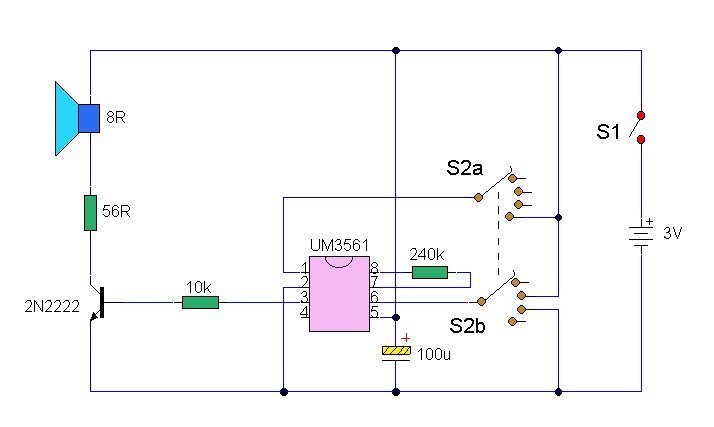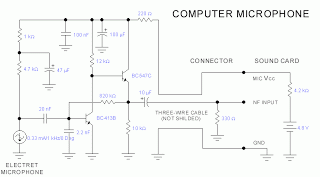
Sound Effects Generators

The integrated circuit (IC) generates various sound effects, with the output at Pin 3 amplified by a transistor. A 64-ohm loudspeaker can replace the 56-ohm resistor and 8-ohm loudspeaker. A two-pole, four-way switch controls the sound effects, with position 1 producing a police siren, position 2 generating a fire engine sound, position 3 emulating an ambulance, and position 4 creating a machine gun effect. The IC is manufactured by UMC and was previously available from Maplin Electronics under the code UJ45Y. As of the time of this writing, this product has been discontinued, although limited stocks may still be available.
The integrated circuit (IC) in question serves as a versatile sound generator, capable of producing a range of audio effects suitable for various applications, such as toy electronics or novelty devices. The amplification of the output signal at Pin 3 is achieved through a transistor, which enhances the audio output to drive a loudspeaker effectively.
In this configuration, the circuit allows for flexibility in speaker choice; a 64-ohm loudspeaker can be utilized in place of the standard 56-ohm resistor and 8-ohm loudspeaker, providing options for different sound output characteristics based on the speaker's impedance.
The sound effects are controlled via a two-pole, four-way switch, which enables the user to select among four distinct audio outputs. Each position of the switch corresponds to a specific sound effect:
- Position 1 activates a police siren, characterized by a wailing sound that is commonly associated with emergency vehicles.
- Position 2 produces the sound of a fire engine, which typically features a distinctive siren sound that signals urgency.
- Position 3 emulates the sound of an ambulance, often recognized by its unique siren tone that differs from that of a police vehicle.
- Position 4 generates a machine gun effect, providing a rapid-fire sound that can be used in various entertainment contexts.
The IC, manufactured by UMC, was previously available through Maplin Electronics with the product code UJ45Y. However, it is important to note that this product has been discontinued, although there may still be limited stock available for purchase. The design and functionality of this circuit make it an interesting component for hobbyists and engineers looking to incorporate sound effects into their electronic projects.The IC produces all the sound effects, the output at Pin 3 being amplified by the transistor. A 64 ohm loudspeaker can be substituted in place of the 56 ohm resistor and 8 ohm loudspeaker. The 2 pole 4 way switch controls the sound effects. Position 1 (as drawn) being a Police siren, position 2 is a fire engine sound, 3 is an ambulance and position 4 is a machine gun effect. The IC is manufactured by UMC and was available from Maplin electronics code UJ45Y. At the time of writing this has now been discontinued, but they have have limited stocks available. 🔗 External reference
The integrated circuit (IC) in question serves as a versatile sound generator, capable of producing a range of audio effects suitable for various applications, such as toy electronics or novelty devices. The amplification of the output signal at Pin 3 is achieved through a transistor, which enhances the audio output to drive a loudspeaker effectively.
In this configuration, the circuit allows for flexibility in speaker choice; a 64-ohm loudspeaker can be utilized in place of the standard 56-ohm resistor and 8-ohm loudspeaker, providing options for different sound output characteristics based on the speaker's impedance.
The sound effects are controlled via a two-pole, four-way switch, which enables the user to select among four distinct audio outputs. Each position of the switch corresponds to a specific sound effect:
- Position 1 activates a police siren, characterized by a wailing sound that is commonly associated with emergency vehicles.
- Position 2 produces the sound of a fire engine, which typically features a distinctive siren sound that signals urgency.
- Position 3 emulates the sound of an ambulance, often recognized by its unique siren tone that differs from that of a police vehicle.
- Position 4 generates a machine gun effect, providing a rapid-fire sound that can be used in various entertainment contexts.
The IC, manufactured by UMC, was previously available through Maplin Electronics with the product code UJ45Y. However, it is important to note that this product has been discontinued, although there may still be limited stock available for purchase. The design and functionality of this circuit make it an interesting component for hobbyists and engineers looking to incorporate sound effects into their electronic projects.The IC produces all the sound effects, the output at Pin 3 being amplified by the transistor. A 64 ohm loudspeaker can be substituted in place of the 56 ohm resistor and 8 ohm loudspeaker. The 2 pole 4 way switch controls the sound effects. Position 1 (as drawn) being a Police siren, position 2 is a fire engine sound, 3 is an ambulance and position 4 is a machine gun effect. The IC is manufactured by UMC and was available from Maplin electronics code UJ45Y. At the time of writing this has now been discontinued, but they have have limited stocks available. 🔗 External reference





